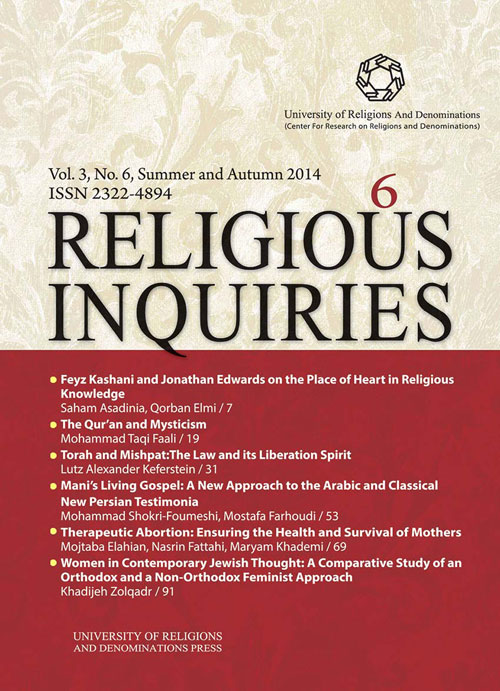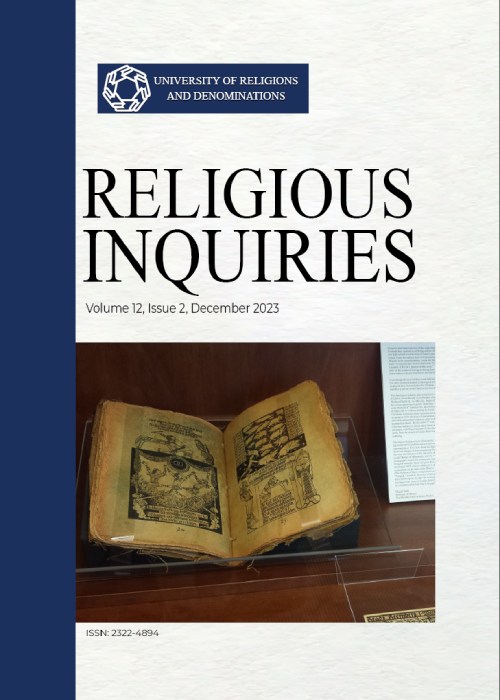فهرست مطالب

Religious Inquiries
Volume:3 Issue: 2, Summer and Autumn 2014
- تاریخ انتشار: 1395/05/25
- تعداد عناوین: 6
-
-
Pages 5-18This essay seeks to summarize and compare the theological ideas of Jonathan Edwards, a western philosopher, with those of Feyz Kashani, an eastern philosopher. The reason for this study is the numerous conjunctions that are seen in their ideas. These include the harmony of heart and reason in respect to belief, the priority of the heart in the reflection of truth, the belief in centrality of the religion of heart, the necessity of divine grace in the flow of religious knowledge, the emphasis on the esoteric side of religion as opposed to the exoteric side, and the importance of a practical approach to religion. Significant differences also exist between their ideas. For instance, Edwards believes that human nature is sinful and corrupted while Feyz does not believe this is true. Furthermore, Feyz interprets the path of heart to be based on reason, while Edwards has a different point of view.Keywords: religious knowledge, Heart, Reason, morality, Feyz Kashani, Jonathan Edwards
-
Pages 19-29The universe has an exterior known as the material world and an interior called the hereafter. So are the Quran and mankind. In other words, the universe, mankind and the Quran have hierarchical stages. The universe and mankind comprise the physical world, but the Quran constitutes the Divine Law. Since the origin of all three is one single source, one can say the former matches the latter, and all are manifestations of the divine Names the Manifest and the Hidden. This idea has long been introduced in mysticism. Using the esoteric interpretation theory, Muslim mystics went for the view that the physical world (takwin) and the Holy Scripture (Book of Law, i.e. the Quran) are in perfect harmony. Therefore, it can be shown that Islamic mysticism is inspired by the Quran and is in fact a Quranic mysticism.Keywords: material world, hereafter, exterior, interior, esoteric interpretation theory, hierarchical stages, Sufism
-
Pages 31-52This essay has two primary objectives. First, acknowledging the fact that the philosophers fundamental responsibility, due to the conditions of social order in many regions and nations around the world, requires not merely thought but also actions that transform this world into a more equitable and inclusive one, the author proposes to show the reader a simple way (among many other possibilities) to connect the Enlightenment discourse of practical reason, acclaimed as a novelty of modernity, with the discourse of so-called symbolic reason, frequently reviled by the worldview of modern scientific and academic communities although experienced on a daily basis by peoples all over the world. Second, the author wishes to present an interpretation of the notion of justice as found in the texts considered sacred within Jewish and Christian communities, contrasting it with the traditional way of defining such a notion, the Ulpian Roman way, upon which the normativity of the self-proclaimed modern peoples is based.Keywords: Enlightenment, Practical Reason, symbolic reason, Paul of Tarsus, Torah, Mishpat, Justice
-
Pages 53-67In order to reconstruct the contents of the most famous work of Mani, Living Gospel (written originally in Syriac), we have to use the Arabic and Classical New Persian texts containing accounts and even indirect quotations of this book. One of the most remarkable points in these accounts is that they clearly show that an important part of the Living Gospel contains the Manichaean Myth of the Creation, the topic which is usually supposed to have no relation with Manis Gospel. The Coptic Manichaean Synaxeis also supports the hypothesis that there were thematically some basic similarities between the Living Gospel and the Ewangelyōnīg hymns. According to the Arabic and Classical New Persian sources, some of the more important subject matters of Manis Gospel were the Land of the Light and of the Darkness, the Mixture and process of the liberatio of the Aeons. These are some of the themes in Manis Gospel that can also be seen in the Ewangelyōnīg hymns. In this article, some of the previous interpretations in this regard have been critically analyzed and challenged.Keywords: Islamic accounts, Mani's Gospel, Ewangelyōnīg hymns, Arabic, New Persian Testimoniess
-
Pages 69-89Siqt janin (abortion) is defined as the intentional or unintentional action that is performed on a pregnant woman, which compromises the life or the foetal development of an unborn baby, such that it dies or cannot continue living out of the uterus. Due to scientific and technological advancement in medicine, the controversy of therapeutic abortion is very much at the forefront of modern discussions. It is also a matter of dispute amongst Muslim jurists. Initial positions and rulings of jurists differ with regards to abortion in the first four months of pregnancy, which is prior to ensoulment (nafkh ruh). Although there is a difference in opinion among Sunni jurists regarding abortion before ensoulment, there is a consensus that under normal circumstances, after this critical juncture, it is forbidden. All Shii jurists, however, deem abortion without due reason, as forbidden regardless of the stage in pregnancy. Even so, most jurists permit the abortion of the foetus prior to ensoulment with the condition that there is substantial danger to expectant mothers health. Moreover, if there is danger to the mothers life, then some consider abortion permissible even after ensoulment.Keywords: Abortion, spiritual inspiration, nafkh ruh, permissibility, prohibition
-
Pages 91-107This paper briefly examines two approaches to the position of women in Judaism. One is from an orthodox perspective, represented by Chana Weisberg, and the other is a non-orthodox and feminist approach, represented by Judith Plaskow. By examining these two approaches, we expect to contribute to a better understanding of the diverse views of women in contemporary Judaism.
Plaskow criticizes the different positions for men and women in Judaism and views them as signs of a womans otherness that has resulted from a patriarchal approach on the part of those who authored the scriptures. For Plaskow, the different positions of men and women can only mean a womans inferiority. Weisberg on the other hand, acknowledges the different positions of men and women, but argues that these differences are indicators of a womans superiority.
Nevertheless, it is fair to state that their preoccupation with either the absolute rejection or acceptance of different positions for men and women has deterred them from addressing the fundamental and undeniable issue of the existence of gender differences. In addition, they have not addressed the possibility of these gender differences as a part of the philosophy behind the different positions of men and women in Judaism.Keywords: Jewish Orthodox feminism, Jewish non, orthodox feminism, gender differences, women's otherness, Plaskow, Weisberg


